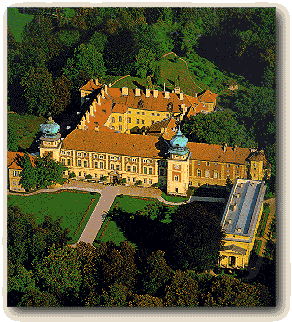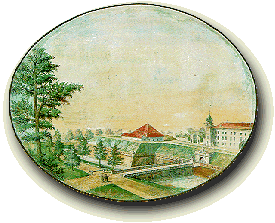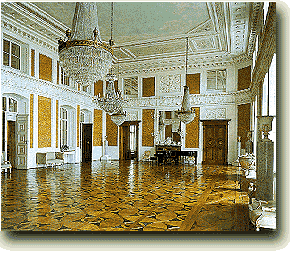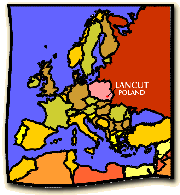| |
|
| The Castle and the Town through the ages. | |
Lancut lies on the fringe of the Carpathian foothills, by an old trade route which linked Western Europe and Ruthenia from medieval times. The town was chartered in 1349, and its first owners were the powerful Pilecki family. They built the first -wooden- defensive manor, in which Poland's monarchs were frequent guests. The Pilecki family is associated with the marriage of King Wladyslaw Jagiello with Elzbieta Granowska nee Pilecka, which provoked a scandal in those days. |
 |
The years 1568-1628 were a time
of ruin for the town. Lancut belonged to the Stadnickis, Stanislaw (the
"Devil of Lancut") Stadnicki and his sons. Adventurism and war against
their neighbours led to the burning and levelling of the castle and
the destruction of the town, which was overrun and sacked by enemies
many times Under the rule
of the Lubomirski family from 1628 to 1816, Lancut came back to life. Under the rule
of the Lubomirski family from 1628 to 1816, Lancut came back to life.
The early seventeenth century was a time of Turkish expansion into Europe, for which reason Stanislaw Lubomirski set out to turn Lancut into a strong fortress to guard against entry into the Republic. The castle was enlarged and surrounded with pentagonal fortifications modelled after the old Dutch style. The defensive system was based on jutting bastions connected by ramparts. The ornamented portal of the palace's western elevation and the exquisite stucco work in the cupola of the Zodiac Chamber, the work of the Italian artist Giovanni Battista Falconi, survive from those times.In the town, the parish church destroyed during the Tartar invasion of 1624 was reconstructed. |
|
In the mid-seventeenth century the castle was considered an unassailable fortress. Thanks to the provisions collected there, the castle's eighty cannon and four hundred soldiers could hold out for three years. When Duke Gyorgy II Rakoczi of Transylvania attacked Lancut in 1657, he burned and looted the town but did not manage to take the castle. With help from the Lubomirskis the townspeople repaired the damage fairly quickly; the parish church and the Dominican monastery were restored. In 1761 the synagogue which stands to this day was built. In the late eighteenth and early nineteenth centuries the fortress was transformed into a palatial residence. The outer ring of fortifications was liquidated, with an English-style park put in its place. The castle interiors were adapted to the fashions of the times. Elzbieta Lubomirska nee Czartoryska, a collector and excellent connoisseur of art, played a large part in this. Eminent architects worked for her, including Szymon Bogumil Zug, Jan Chrystian Kramsetzer and Chrystian Piotr Aigner. Many of the rooms remodelled then have survived unchanged to the present, among them the Chinese Chamber, Salon Boucher, the Ballroom and Columned Chamber, the Grand Dining Room and the Chapel. |
  |
| The next and last
owners of Lancut were the Potockis, who were tied by marriage to all
of Europe's aristocracy. The palace we see today is the result of their efforts in 1889-1911. They faithfully maintained the grand interiors from the days of the Lubomirskis, concentrating more on introducing modern conveniences. They put in a water and sewer system, and added luxurious bathrooms to the chambers. The number of bathrooms must have shocked their contemporaries: after a tour of the castle, Roman Potocki's mother declared that its interior reminded her of Dianabad, the largest public baths in Vienna. |
|
  |
In 1906 the castle gained an electrical
system with its own generator. The last interior to be modernised was the palace theatre, renovated to the designs of Viennese architects.The palace surroundings changed as well. The park area nearly doubled. An Italian garden and a rose garden were added, and orchid and palm houses were built, the latter modelled after the palm house in Schönbrunn. The Potockis remembered the townspeople as well. At the turn of the century they completely renovated the parish church. The distillery founded by the Lubomirskis was modernised and enlarged, producing the quality-famed spirits of Count Alfred Potocki's Privileged Distillery of Liqueurs, Rosoglios and Rum. During the occupation, German army staff were stationed in the castle. When the outcome of World War II became obvious to everyone, Alfred III Potocki, the last of Lancut's lords, dispatched about six hundred crates to Vienna by rail, containing the most valuable works of art. Among them were paintings by Bellini, Boucher, Fragonard and Watteau, eighteenth-century tapestries manufactured in Aubusson, sculptures by Thorvaldsen . . . Alfred III himself abandoned Lancut a week before the Soviet army crossed into Poland, never to return again. That the residence was spared plunder and destruction at the hands of the Soviets is due to the courage and resourcefulness of the palace staff, and their loyalty to Potocki. |
|
| |